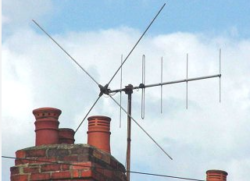A revolutionary invention and one we’d be lost without, the unassuming TV aerial is a fixture of modern life. Although most of us use one every day, we rarely consider this clever gadget – unless something goes wrong, of course! So how did the modern TV aerial evolve?
Here’s a short history of the TV aerial, from the clunky ‘rabbit ear’ antenna to today’s sleek rooftop fixture.

Humble Beginnings
In the early 20th century, television was born. Inventors rushed to create ways to transmit moving images, and the very first working TV system was demonstrated by pioneer John Logie Baird in 1926. There were huge limitations, though. Early transmissions faced reception difficulties, and so a need for new technology arose.
The ‘rabbit ear’ style antennae were introduced in the 1930s and 1940s. These adjustable telescopic antennas could capture over-the-air signals and boost reception. However, they often needed tweaking and could quickly lose reception. During this time, television broadcasting was soaring in popularity, so technology began to quickly evolve.
The 1950s to 1970s
With popularity building, the 50s and 60s brought about a big shift in TV technology with the emergence of VHF (Very High Frequency) and UHF (Ultra High Frequency) broadcasting. New antennas were developed to target these brand-new frequencies, and by the 1970s, rooftop antennas had taken hold. These boasted a superior signal reception in comparison to temperamental indoor alternatives, capturing signals from a wider range and offering more channels.
For those seeking TV aerial installation Stroud and the wider area, specialists such as https://steveunettaerials.co.uk/our-services/aerial-services/tv-aerial-repair/tv-aerial-repair-stroud/ can offer solutions.
The 21st Century
In the early 21st century, the transition from an analogue to a digital TV signal was a revolution and the digital television (DTV) switchover occurred.

Today, our favourite streaming services and web-based content are a huge part of the TV industry. Satellite dishes, cable connections and online connections are common as well as the traditional rooftop antennas. From the temperamental rabbit ears of TV’s inception to today’s super-sophisticated rooftop antennas, the journey of the TV aerial shows us how quickly our technological landscape can change.
